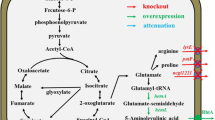Abstract
Objective
To construct a strain of Corynebacterium glutamicum capable of efficiently producing 5-aminolevulinic acid (5-ALA) via the C4 pathway by modification of serine and glycine pathway using glucose as sole carbon source.
Results
The recombinant C. glutamicum strain AP2 harboring a codon-optimized hemA gene from Rhodobacter sphaeroides was used as host strain for 5-ALA production. A plasmid harboring the serine operon, which contained serB, serC and the site-specific mutant serA Δ197, was constructed and introduced into C. glutamicumAP2, leading to an increase of 70% in 5-ALA production. Further overexpression of the glyA gene increased production of 5-ALA by 150% over the control. 5-ALA production was thus significantly enhanced by engineering the glycine biosynthetic pathway. C.glutamicum AG3 produced 3.4 ± 0.2 g 5-ALA/l in shake-flask cultures in CGIIIM medium with the addition of 7.5 g glycine/l.
Conclusion
This is the first report of remodeling the serine and glycine biosynthetic pathway to improve the production of 5-ALA in C. glutamicum.



Similar content being viewed by others
References
Chung S-Y, Seo K-H, Rhee JI (2005) Influence of culture conditions on the production of extra-cellular 5-aminolevulinic acid (ALA) by recombinant E. coli. Proc Biochem 40:385–394
Feng L, Zhang Y, Fu J, Mao Y, Chen T, Zhao X, Wang Z (2016) Metabolic engineering of Corynebacterium glutamicum for efficient production of 5-aminolevulinic acid. Biotechnol Bioeng 113:1284–1293
Fu W, Lin J, Cen P (2008) Enhancement of 5-aminolevulinate production with recombinant Escherichia coli using batch and fed-batch culture system. Bioresour Technol 99:4864–4870
Fu W, Lin J, Cen P (2010) Expression of a hemA gene from Agrobacterium radiobacter in a rare codon optimizing Escherichia coli for improving 5-aminolevulinate production. Appl Biochem Biotechnol 160:456–466
Gu P, Yang F, Su T, Li F, Li Y, Qi Q (2014) Construction of an l-serine producing Escherichia coli via metabolic engineering. J Ind Microbiol Biotechnol 41:1443–1450
Hemanshu M, Konstantin S, Hanne BC, Alex TN (2016) Engineering of high yield production of l-serine in Escherichia coli. Biotechnol Bioeng 113:807–816
Kang Z, Wang Y, Gu P, Wang Q, Qi Q (2011) Engineering Escherichia coli for efficient production of 5-aminolevulinic acid from glucose. Metab Eng 13:492–498
Kiatpapan P, Murooka Y (2001) Construction of an expression vector for propionibacteria and its use in production of 5-aminolevulinic acid by Propionibacterium freudenreichii. Appl Microbiol Biotechnol 56:144–149
Lai S, Zhang Y, Liu S, Liang Y, Shang X, Chai X, Wen T (2012) Metabolic engineering and flux analysis of Corynebacterium glutamicum for l-serine production. Sci China Life Sci 55:283–290
Ma W, Wang X, Mao Y, Wang Z, Chen T, Zhao X (2015) Development of a markerless gene replacement system in Corynebacterium glutamicum using upp as a counter-selection marker. Biotechnol Lett 37:609–617
Netzer R, Peters-Wendisch P, Eggeling L, Sahm H (2004) Cometabolism of a nongrowth substrate: l-serine utilization by Corynebacterium glutamicum. Appl Environ Microbiol 70:7148–7155
Peters-Wendisch P, Netzer R, Eggeling L, Sahm H (2002) 3-Phosphoglycerate dehydrogenase from Corynebacterium glutamicum: the C-terminal domain is not essential for activity but is required for inhibition by l-serine. Appl Microbiol Biotechnol 60:437–441
Peters-Wendisch PS, Etterich H, Kennerknecht N, Sahm H, Eggeling L (2005) Metabolic engineering of Corynebacterium glutamicum for l-serine production. Appl Environ Microbiol 71:7139–7144
Pittard YZJPAHA (1994) Molecular analysis and characterization of a broad-host-range plasmid, pEP2. J Bacteriol 176:5718–5728
Qin G, Lin J, Liu X, Cen P (2006) Effects of medium composition on production of 5-aminolevulinic acid by recombinant Escherichia coli. J Biosci Bioeng 102:316–322
Schweitzer JE, Stolz M, Diesveld R, Etterich H, Eggeling L (2009) The serine hydroxymethyltransferase gene glyA in Corynebacterium glutamicum is controlled by GlyR. J Biotechnol 139:214–221
Simic P, Willuhn J, Sahm H, Eggeling L (2002) Identification of glyA (encoding serine hydroxymethyltransferase) and its use together with the exporter ThrE to increase l-threonine accumulation by Corynebacterium glutamicum. Appl Environ Microbiol 68:3321–3327
Unthan S et al (2014) Beyond growth rate 0.6: what drives Corynebacterium glutamicum to higher growth rates in defined medium. Biotechnol Bioeng 111:359–371
Xu G et al (2015) Enhanced production of l-serine by deleting sdaA combined with modifying and overexpressing serA in a mutant of Corynebacterium glutamicum SYPS-062 from sucrose. Biochem Eng J 103:60–67
Zhang X, Xu G, Li H, Dou W, Xu H, Xu Z (2014) Effect of cofactor folate on the growth of Corynebacterium glutamicum SYPS-062 and l-serine accumulation. Appl Biochem Biotechnol 173:1607–1617
Zhu N, Xia H, Wang Z, Zhao X, Chen T (2013) Engineering of acetate recycling and citrate synthase to improve aerobic succinate production in Corynebacterium glutamicum. PLoS ONE 8:e60659
Acknowledgements
This work was supported by the Natural Science Foundation of Tianjin (No. 15JCQNJC06000).
Supporting information
Supplementary Table 1—Strains and plasmids used.
Supplementary Table 2—Primers used.
Author information
Authors and Affiliations
Corresponding author
Electronic supplementary material
Below is the link to the electronic supplementary material.
Rights and permissions
About this article
Cite this article
Zou, Y., Chen, T., Feng, L. et al. Enhancement of 5-aminolevulinic acid production by metabolic engineering of the glycine biosynthesis pathway in Corynebacterium glutamicum . Biotechnol Lett 39, 1369–1374 (2017). https://doi.org/10.1007/s10529-017-2362-x
Received:
Accepted:
Published:
Issue Date:
DOI: https://doi.org/10.1007/s10529-017-2362-x




